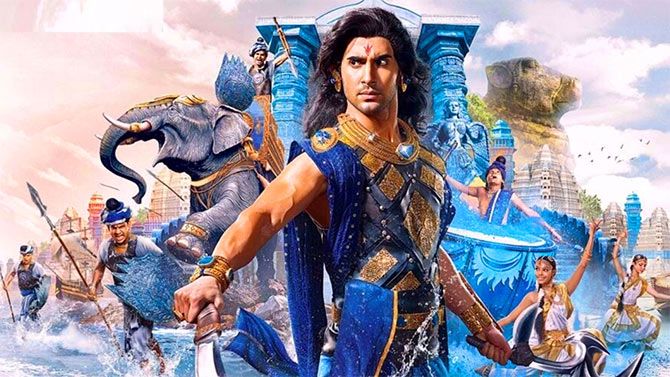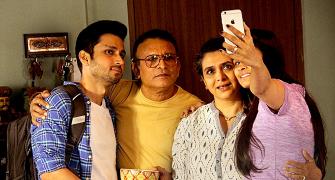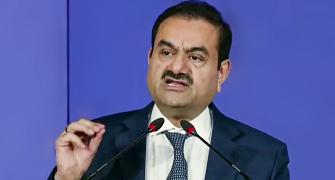Mythological and historical shows are lapped up not just by the young, but equally by grown men and women.
Ritwik Sharma and T E Narasimhan report.

A dark-skinned goddess brandishes an axe at her consort.
A prince and his bride exchange vows before the sacred fire and calmly slay enemies amid their wedding ritual.
In a modern household, a woman stuns another by revealing that her feet aren't on the ground.
These stray scenes are from Mahakali, Porus and Naagin 3 respectively, television shows that represent the differing genres of mythological, historical and fantasy drama.
Back in the 1980s, Ramanand Sagar's Ramayan and B R Chopra's Mahabharat hooked audiences across classes to set a trend with two blockbuster epics.
Today, a vibrant mix of mythological and historical content is striving to create a similar impact on viewers at a time when self-proclaimed nationalists in the ruling establishment routinely proffer colourful interpretations of the two.

The bouquet of content that major networks are offering is wide: They range from Mahakali: Anth Hi Aarambh Hai on Colors and Vighnaharta Ganesha on Sony; the conversational Devlok with Devdutt Pattanaik, which delves into mythology, to fictional accounts and historical figures in Porus (Sony) and Tenali Rama (Sony SAB); and the devotional Mere Sai: Shraddha Aur Saburi (Sony).

Data for Hindi general entertainment channels recorded by the Broadcast Audience Research Council India show that mythological and historical programmes are lapped up not just by the young, but equally by grown men and women.
During prime-time viewing (6 pm to 11 pm), men in fact edge women out with 51 per cent share of viewership.
Madhya Pradesh and Chhattisgarh combine to form the biggest market with 20 per cent share of contribution to viewership in the mythological and costume drama segment.
Chennai resident R Balaji, 38, is happy to rush home after work to join his wife and seven-year-old daughter to watch what he considers a welcome change from melodramatic soaps -- Tenaliraman.
Zee Tamil has acquired rights from SAB TV to air Tenaliraman, a dubbed version of the Hindi , a serial conceived for the family but not positioned as a 'mass show', with its scant reliance on melodrama.
"Such programmes will not only teach history, culture and ways of life but also help my child get an idea of folklore and mythological characters," says Balaji.

Indians are prone to escapism, as evidenced by 54 per cent viewership being driven by GEC and another 23 per cent by movie channels, according to a report by the Federation of Indian Chambers of Commerce and Industry and EY Consultancy.
Siddharth Kumar Tewary, founder and creative director, Swastik Productions, believes that mythological and historical stories can be interpreted freshly to make them relevant for today's audience.
Tewary has made a number of television series including Mahabharat (2013) and Mahakali, and has produced and directed Porus -- the first show where the producer also owns the intellectual property rights.
Produced with a budget of Rs 5 billion and based on the eponymous Indian king who fought against Greek emperor Alexander, it has been distributed across 10 nations in six months.
"To create good content, you have to invest in it," says Tewary.
He concedes that series on epics such as the Mahabharata are better received than those on less known mythological characters. But he also aims to demystify popular beliefs with productions such as Karmaphal Data Shani, a heroic rendition of a deity considered to be a harbinger of misfortune.

The popularity and appeal of the Ramayan and Mahabharat of the 1980s has, however, remained unmatched despite several attempts.
For the Sagar family, epics must be portrayed in a way that conforms to the beliefs audiences have been brought up with.
Meenakshi Sagar, Ramanand Sagar's grand-daughter, says the bhakti and bhav (devotion and spirituality) that came with the originals are lacking in newer productions.
"It is more visual stimulation than spiritual now, as the focus has shifted to attracting younger audiences," she says, adding that while there has been a resurgence of such serials in the past five years, after starting out impressively in terms of visual representation they weaken as the rut of delivering episodes sets in.
There have been multiple serials on figures such as Ganesha and Hanuman.
According to Neeraj Vyas, business head of Sony SAB, PAL, Hindi movies and music cluster (MAX, MAX2, MIX) and Sony Pictures Networks India, changing technologies allow for the retelling of epics every five years with new visuals.
SAB's next big production is Aladdin.
"There are a lot of things that the character of Aladdin did but which have not been narrated. We are presenting him as the Aladdin of 2018," says Vyas, promising to go beyond the genie and the magic lamp and carpet.

Arka Media Works, producers of the smash-hit Baahubali franchise, has launched a period fantasy story (Swarna Khadgam) on ETV Telugu, with plans to dub it in other languages including Hindi.
"To attract audiences, initially a novelty factor is required, which could be brought in through CGI (computer-generated imagery). But the story has to be good for the audience to stay," says its producer Shobu Yarlagadda.
Some mythological stories are popular only in a specific region. Sony feels stories from the South are, however, grabbing eyeballs across India.
The broadcaster has recently completed Prithvi Vallabh: Itihaas Bhi, Rahasya Bhi, a series on a Chalukya queen and Malwa king who represent present-day Madhya Pradesh and Karnataka. It is considering tales of Chola emperor Raja Raja Chola and is also looking at Parashurama, the sixth avatar of Vishnu.
Another major player in the genre is Zee TV.
History, mythology and fantasy form an integral part of its offerings. Prathyusha Agarwal, chief marketing officer, Zee Entertainment Enterprises, says bigger TV screens in households invite larger-than-life fantasies. She argues that this has resulted in more time being spent on these shows in urban India as well.
Viewers in the 15 to 21 age bracket are also growing in this genre.
"The fantasy and mythology genre has a higher return on investment for broadcasters," she says. This, in effect, means that these shows draw more advertisers.

In the last decade, the kids' category has also been spurred by the rise of the local animation industry.
This category of 2- to 14-year-olds forms 20 per cent of the total TV impressions, the highest share across age groups, according to BARC. (Impressions is the number of target households in thousands where the show was on, averaged across minutes.)
Rajiv Chilaka, CEO and founder of Green Gold Animation, observes that from six animation channels in 2008, the number has risen to 20-odd, but there still isn't enough content.
Chilaka created the memorable Chhota Bheem, which premiered in 2008 on Pogo TV.
Although the character was derived from the Mahabharata, he says it cuts across demographics and religions.
In the kids' space, mythology hasn't had much success, as original content finds greater connect, while those aged 11 to 14 continue to be attracted more to international content.

For all its appeal cutting across demographics, mythological and costume dramas (as historical characters-based serials are categorised) pale in comparison to the popular series in GEC.
According to BARC data for June 16 to July 17, 2018, Naagin 3 -- currently the most popular programme -- recorded 14.57 million impressions whereas a mythological serial like Mahakali drew merely 2.78 million.
Porus recorded 24.39 million, Vignaharta Ganesh registered 22.4 million and Tenali Rama, which falls under drama, drew 23 million impressions.
Sandeep Goyal, chairman of the marketing and communication agency Mogae Media, says that mythology has been relegated to a "good-to-have" category.
More tellingly, he adds, mythology has technically turned into "down-market content" with its reach being confined to the lower rungs, rather than cutting across social strata as in the 1980s.
He jokes that on being quizzed, a friend from the television industry replied that in over two decades, mythological shows had progressed to a point where Ganesha's proboscis, long rendered motionless for lack of technological advances, was now starting to move.

"Mythology has been underpaid, underfinanced and, therefore, looks primitive," Goyal says, adding that after the game-changing Kaun Banega Crorepati and, to a much smaller extent, Bigg Boss, family sagas and dance shows have remained the staple on television.
He expects that the content game will be changed soon by over-the-top (OTT) players such as streaming platform Netflix, which invested in the best local talent to produce India's first original series Sacred Games.
"OTT players are far more aggressive, cater to a young audience and are not under as much pressure from advertisers."
It is a given that mythological and fabular characters will never run out of fashion in a country where faith and spirituality trump rationality.
From content creators to experts, everyone believes their predominance in the entertainment industry is not because of, but despite, the rise of right-wing Hindu revivalism in the political sphere.

Utkarsh Patel, professor of comparative mythology at Mumbai University, says that mythological and costume dramas today are more technically sound, with a glossier look-and-feel, and greater focus on attire, ornaments and weapons (borrowed from Western concepts).
"But the stories are not very crisp, tend to drag and have little resemblance to the scriptures."
He feels that because of the fictionalisation of content, the viewer is more entertained than educated, although an infotainment channel such as Epic does provide accurate and educative programmes.
For Patel, India is a "living mythology".
"All of us know the stories of the Ramayana and Mahabharata even without reading them. That is why we make analogies such as 'eating like Bhima' or 'laughing like Hidimba'. It is impossible to separate mythology from Indians," he says.
It is a persuasive argument.
What, otherwise, explains that even a crime drama like Sacred Games begins tantalisingly with an episode titled Ashwathama, an eponymous character from the Kurukshetra War?
Urvi Malvania contributed to this report.











